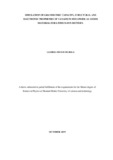SIMULATION OF GRAVIMETRIC CAPACITY, STRUCTURAL AND ELECTRONIC PROPERTIES OF VANADIUM DISULPHIDE AS ANODE MATERIAL FOR LITHIUM-ION BETTERY
Abstract
Various energy sources are utilized at present with a challenge of energy storage in many cases. The existing rechargeable storage batteries which include sodium-ion and lithium-ion have some limitations in their gravimetric capacities. This can be improved by incorporating Vanadium disulphide (VS2) due to its metallic properties at ground state. In this work we investigate the adsorption of lithium ions on the VS2 layered material. Research shows that intercalating lithium ions on a monolayer VS2 leads to a high energy capacity anode material but this has faced a challenge in obtaining the monolayer slab experimentally. For this reason, the ab-initio method based on density functional theory (DFT) was used to investigate the adsorption of lithium ions on layered Vanadium disulphide with no bonds in the positive electrode being broken. All calculations were done within the DFT framework and a plane wave basis set as implemented in Quantum Expresso code. The projector augmented wave (PAW) pseudo potentials were used to describe the electron-electron interaction. From the calculation H-phase monolayer VS2 was found to be stable at room temperature maintaining the hexagonal structure. Also pure and lithium adsorbed VS2 was found to be electronically stable with zero band gap thus the metallic state is maintained upon intercalation. VS2 gives a maximum gravimetric capacity of 466mhA/g showing that it offers a more favorable adsorption sites for lithium atoms. With the structural and electronic stability of VS2 coupled with a high gravimetric capacity, VS2 is an effective anode material for a high storage capacity lithium ion battery. Thus can be applied in electrical devices.

